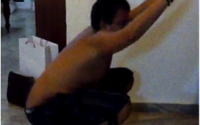Movement is Driven
This is a key concept in the change of mindset between the traditional view of anatomy and movement. Instead of using muscles to create movement, ‘the quads extend the knee’ etc. Like most, when I was a personal trainer and at Uni I learned all the muscles and the joint movements they create when the muscle shortens. I would suggest a change to thinking of it as ‘what does the muscle reacts to?’ In some ways it’s a subtle shift, but it’s actually a very important change.
Instead of thinking that the soleus plantarflexes the ankle, think about what it reacts to and you’ll find out a lot more about how it really functions. Clearly, it is task specific, but if we use gait for example the soleus will be reacting to the dorsiflexion produced by the anterior rotation of the tibia during the stance phase.
The soleus fires at this point to slow down the anterior rotation of the tibia as the mass and momentum of the body travels over the stance foot. The action of the soleus here slows the tibia relative to the femur, creating knee extension. Now you won’t find that in your anatomy textbook, but that’s the function of the soleus in gait. The point is that the soleus is driven to react, so doing calf raises will make the muscles work, but that’s not how it functions in gait.
I’d say most of the exercises people start off with are consciously driven by muscle activation, for example standard rotator cuff exercises, knee extensions, clams, bridges, etc. Clearly, these may be appropriate for some patients, but it’s rare I regress someone that far. If we want someone out functioning well in the real world I want their rehab to be a lot closer to function, which means make the target tissue react to and feel the motion.
The two simple questions you have to ask when looking at a movement are:
- What is driving this motion?
- Where is it being driven from?
This is vital whether you are assessing movement or building exercises. If you understand this you have a great start. In the clinic the most common time this comes in handy is when people have neck pain. I’ll look at their movement in the traditional way to see what they can do, this is top down driven motion…the head is driving the neck from above. Then I will get them to go through some arm and shoulder movements and see how the neck moves then. This will be bottom up driven motion, i.e. the body is driving the neck from below. It’s incredible the difference you often see in ranges of motion. We will cover this concept a lot more in this series of books.
The final example I will use to show how important it is to know about how movement is driven is in gait. When you are walking the front leg load is primarily driven by the gravity and ground reaction force of the foot hitting the floor. It is these forces that create the bone motions, joint feelings and muscle reactions we know as pronation or loading.
However, once this reaction has happened we are only half way. There is a lot left to get done before a complete gait cycle has been achieved. This is where mass and momentum takes over. The swing leg provides the force that assists the ‘explode’ of these muscles. The mass and momentum of the swing leg drives forces down the standing leg to help drive supination or unloading during the second phase of gait.
I’ve introduced a lot of concepts here, but we’ll get into these gradually over time. If you have any specific questions feel free to ask them in the comments.
Physioblogger

